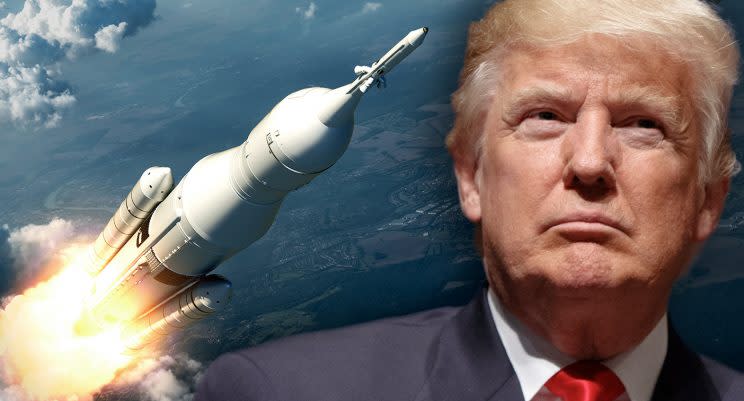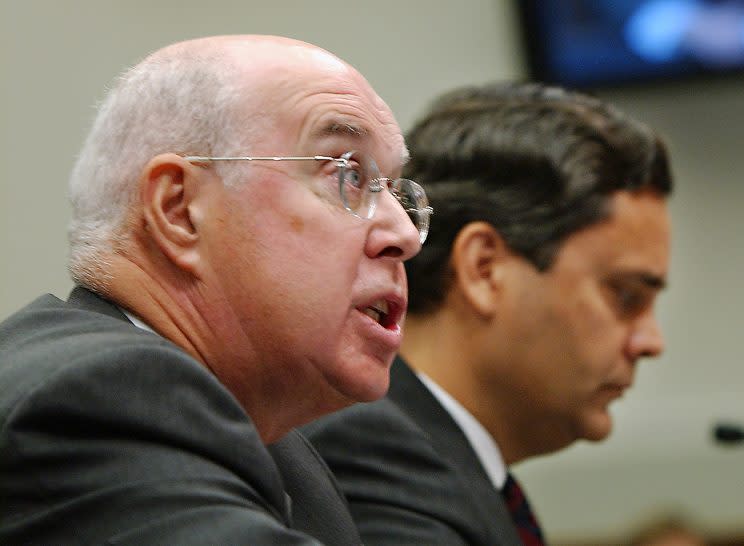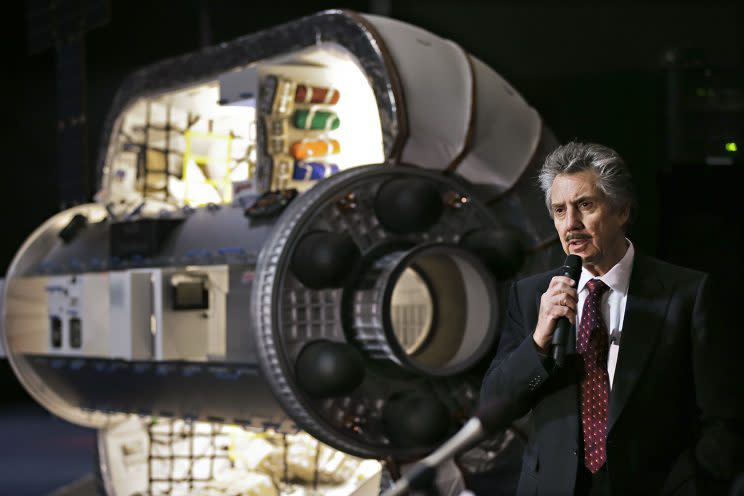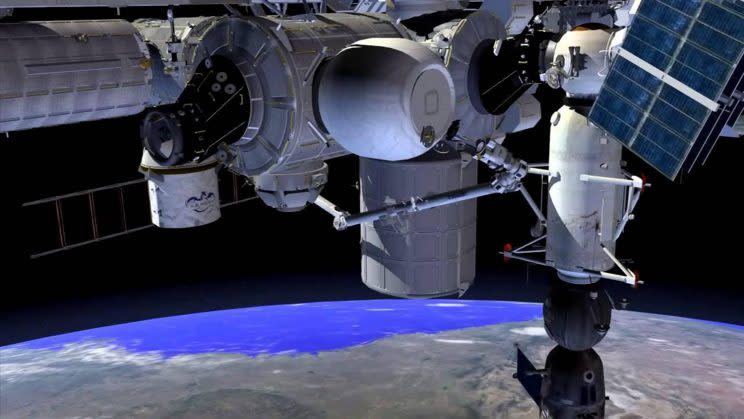
In perhaps the most poetic passage from his inaugural address, President Trump said, “We stand at the birth of a new millennium, ready to unlock the mysteries of space.” So, how does Trump intend to do that?
Former Congressman Robert Walker, R-Pa., who was tapped to draft Trump’s space policy during the campaign, spoke to Yahoo News about the administration’s plan to place “low Earth orbit” missions predominantly in the hands of the private sector, with exceptions for military and intelligence satellites. The government would not compete with commercial interests in this region of space; instead, NASA would concentrate on deep-space exploration with the long-term goal of having humans explore the entire solar system by the 22nd century.
A number of private entities, such as Axiom Space and Bigelow Aerospace, are interested in creating commercial space stations and have technologies under development — such as constellations of satellites for Earth observation or new communications tools — that they believe can be profitable in low Earth orbit, the region of space up to an altitude of about 1,200 miles. It’s the easiest orbit to enter and maintain. The International Space Station (ISS) is in low Earth orbit.
There are already commercial organizations prepared to lift supplies that NASA needs for deep-space exploration into low Earth orbit for assembly.
“As we look toward going back to the moon, going to Mars or further, we’ll want to have space resources that would be assembled in orbit so we could make them large enough and capable enough to do real deep-space activities,” Walker said.
Walker has extensive experience in the space sector. He was the first sitting member of Congress to receive NASA’s Distinguished Service Medal, the agency’s highest honor, and has been heavily involved in presidential commissions on the aerospace industry’s future and space exploration.
Walker believes space policy must acknowledge that the space community is far bigger than NASA or the military and that private investors should take the opportunity to participate in achieving national goals. He is calling for the National Space Council, a policy-setting body disbanded in 1993, to be reconstituted under the leadership of the vice president to set national goals for all three stakeholders in space: commercial, military and civilian interests.

The questions to address, he said, are “What’s the best way for us to access space in the future? And what opportunities exist if you’re truly innovative about how your approach a space future?”
Michael Suffredini, another recipient of the NASA Distinguished Service Medal, has more than 30 years of human space flight experience, has managed the ISS for 10 years and is CEO and president of Axiom Space, which is currently developing the first private, commercial space station. It is intended to be the successor to the ISS after its retirement in 2024.
Along with providing a facility for research, Axiom plans to offer human space flight programs for countries that wish to send their own astronauts into space and for space tourists who want to orbit the Earth for 7 to 10 days.
According to Suffredini, NASA has already been on a path toward commercializing low Earth orbit, and the Trump administration is interested in continuing this process.
“We think the time is right for an almost completely — from a development, launch and operations standpoint — commercial platform in low Earth orbit that can replace what the ISS brings to the table when it’s ready to retire,” Suffredini told Yahoo News. “The Trump administration’s plan forward really supports what we’re interested in doing.”
He’s hopeful that the administration will support commercial endeavors moving out to cislunar space (the area between the Earth and the moon) as well as to the moon or even Mars. We can all debate, he said, how much commercial activity will happen beyond low Earth orbit in the near future.
“[The administration’s] thrust is to look at more and more ways to look at commercial entities to participate where they want to in space,” Suffredini said.

Robert Bigelow, the founder and president of Bigelow Aerospace, said major aircraft manufacturers Boeing and Lockheed Martin — “the big guys” — have always had a lock on NASA and therefore on government money. He said privatizing low Earth orbit is a tremendous opportunity for “the little guys” to survive and build a thriving business.
“This is a completely new era. The circumstances have been changed, because NASA is cash-poor,” Bigelow said. “Not only does it make sense, but it’s an absolute necessity.”
Bigelow, who has argued that NASA’s roughly $19 billion budget should be doubled, recalled conservations with William H. Gerstenmaier, the associate administrator for the Human Exploration and Operations Directorate at NASA, indicating that the agency does not have the resources to return humans to the moon (or accomplish similar lofty goals) — without help from the private sector.
Bigelow Aerospace, based in North Las Vegas, Nev., develops expandable space station modules and other resources that could assist human space exploration — whether to low Earth orbit, the moon, Mars or deep space. Bigelow said NASA and other national space agencies worldwide are prospective clients.
Aside from unmanned satellites, there are at this time no moneymaking, private operations in low Earth orbit, other than those catering to the ISS, such as the BEAM (Bigelow Expandable Activity Module).
“There is nothing that private enterprise can’t successfully take on, do more affordably and more quickly than any government operation can,” Bigelow said. “Private enterprise hasn’t had the chance.”

He said three things are necessary for any space activity: money, technology and legal permission, which itself requires political wherewithal.
“The private sector invents technology and generates huge amounts of money, so the political permission is the stopping point,” he continued. “Up until the current time, aside from satellite communications, space has always been the domain of NASA as far as the United States is concerned. That is changing.”
On Wednesday, Robert Lightfoot, the acting administrator for NASA, said in an agency update that the transition under the Trump administration is going smoothly. He also asked NASA’s human exploration and operations mission directorate to look into the feasibility of adding astronauts to Exploration Mission 1 (EM-1), the first planned flight of the new Space Launch System (SLS) rocket and second flight of the Orion spacecraft, accelerating human exploration in deep space. With EM-1, NASA is developing the technologies that would be needed for a journey to Mars.
While speaking to a conference of suppliers for the SLS and other projects, Lightfoot emphasized the importance of private and public space industries in reaching the country’s goals.
“We must work with everyone to secure our leadership in space — and we will,” he said.
According to NASA, the SLS and Orion missions (together with record levels of private investment in space) would ensure the United States’ leadership role in exploring the cosmos and put us closer to unlocking “the mysteries of space.”
Back in October, the Trump campaign called Walker and asked him to draft its space policy. He agreed and said he could come up with one in a few days, but the Trump team said they needed it much faster. Walker and Peter Navarro, Trump’s chief trade adviser, put together what they consider a cohesive space policy within 48 hours.
“I was thrilled to help them. This has been a long-duration mission of mine to get our space program as robust as possible, and I have been particularly an advocate for commercial space for a long time,” Walker said.
Navarro would run their ideas by Trump’s team, and they would offer suggestions that ultimately wound up in the policy, such as a focus on hypersonics (speeds of Mach 5 and above).
Afterward, Trump would mention space as part of his larger vision for the country. Vice President Mike Pence also held a roundtable in Florida during the campaign in which he outlined a space program that resembled Walker’s outline.
At a campaign rally on Oct. 25 in Sanford, Fla., roughly an hour’s drive from the Kennedy Space Center, Trump said, “I will free NASA from the restriction of serving primarily as a logistics agency for low Earth orbit activity — big deal. Instead, we will refocus its mission on space exploration. Under a Trump administration, Florida and America will lead the way into the stars.”
Follow @mavenstark
Mavenvision Stock Imagery Featuring high quality, royaltie-free images available for purchase on Bigstock
Mavenvision Stock
Mavenimagery
Mavenmantes EyeEm collection
Madeira Beach, Florida
Photopia Products and Image Storage available for purchase We currently offer a number of print products for shipment to addresses in the United States. Shipping to addresses outside of the US is currently not supported. The basic membership is free of charge. This provides you with storage for 100 images that may be included in Photopia as products at any one time.
Photopia is a new way to share and sell your photographs and digital images.




No comments:
Post a Comment